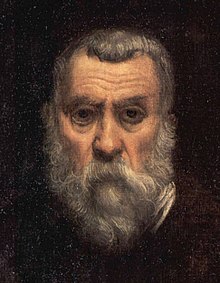Tintoretto
Appearance

Tintoretto (born Jacopo Robusti; late September or early October, 1518 – May 31, 1594) was an Italian painter identified with the Venetian school. His contemporaries both admired and criticized the speed with which he painted, and the unprecedented boldness of his brushwork. For his phenomenal energy in painting he was termed Il Furioso ("The Furious").
| This article about an artist is a stub. You can help out with Wikiquote by expanding it! |
Quotes about Tintoretto
[edit]- Titian, Tintoretto, and Paul Veronese absolutely enchanted me, for they took away all sense of subject. ... It was the poetry of color which I felt, procreative in its nature, giving birth to a thousand things which the eye cannot see, and distinct from their cause.
- Washington Allston, as quoted in The Quotable Artist (2002) by Peggy Hadden, p. 20
- In that Renaissance (Cellini, Tintoretto, Titian..) there was an explosion of unique truthfulness, a love of painting and form.. ..Then come the Jesuits and everything is formal; everything has to be taught and learned. It required a revolution for nature to be rediscovered; for Delacroix to paint his beach at Etratat, Corot his roman rubble, Courbet his forest scenes and his waves. And how miserable slow that revolution was, how many stages it had to go through!.. ..These artists had not yet discovered that nature has more to do with depth than with surfaces. I can tell you, you can do things to the surface.. ..but by going deep you automatically go to the truth. You feel a healthy need to be truthful. You’d rather strip your canvas right down than invent or imagine a detail. You want to know.
- Paul Cézanne in: Joachim Gasquet’s Cézanne, - a Memoir with Conversations, (1897 - 1906); Thames and Hudson, London 1991. pp. 156-157, in: 'What he told me – I. The motif'
- Great art, for those who insist upon this rather philistine concept (as if un-great art were unworthy of even their most casual and ill-informed attention), makes us stand back and admire. It rushes upon us pell-mell like the work of Rubens or Tintoretto or Delacroix, or towers above us. There is of course another aesthetic: the art of a Vermeer or a Braque seeks not to amaze and appal but to invite the observer to come closer, to close with the painting, peer into it, become intimate with it. Such art reinforces human dignity.
- Germaine Greer. The Obstacle Race (1979) Chapter V: Dimension (p. 105)

